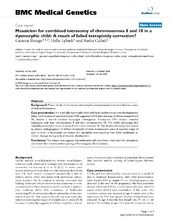| dc.contributor.author | Houge, Gunnar | en_US |
| dc.contributor.author | Lybæk, Helle | en_US |
| dc.contributor.author | Gulati, Sasha | en_US |
| dc.date.accessioned | 2009-09-07T13:04:39Z | |
| dc.date.available | 2009-09-07T13:04:39Z | |
| dc.date.issued | 2009-05-18 | eng |
| dc.Published | BMC Medical Genetics 10(42) | en |
| dc.identifier.issn | 1471-2350 | |
| dc.identifier.uri | https://hdl.handle.net/1956/3440 | |
| dc.description.abstract | Background: Mosaic whole-chromosome tetrasomy has not previously been described as a cause of fetal malformations. Case presentation: In a markedly dysmorphic child with heart malformations and developmental delay, CGH analysis of newborn blood DNA suggested a 50% dose increase of chromosomes 8 and 18, despite a normal standard karyotype investigation. Subsequent FISH analysis revealed leukocytes with four chromosomes 8 and four chromosomes 18. The child's phenotype had resemblance to both mosaic trisomy 8 and mosaic trisomy 18. The double tetrasomy was caused by mitotic malsegregation of all four chromatids of both chromosome pairs. A possible origin of such an error is incomplete correction of a tetraploid state resulting from failed cytokinesis or mitotic slippage during early embryonic development. Conclusion: This unique case suggests that embryonic cells may have a mechanism for tetraploidy correction that involves mitotic pairing of homologous chromosomes. | en_US |
| dc.language.iso | eng | eng |
| dc.publisher | BioMed Central | eng |
| dc.title | Mosaicism for combined tetrasomy of chromosomes 8 and 18 in a dysmorphic child: A result of failed tetraploidy correction? | en_US |
| dc.type | Peer reviewed | |
| dc.type | Journal article | |
| dc.description.version | publishedVersion | en_US |
| dc.rights.holder | Houge et al; licensee BioMed Central Ltd. | |
| dc.identifier.doi | https://doi.org/10.1186/1471-2350-10-42 | |
| dc.identifier.cristin | 350664 | |
| dc.subject.nsi | VDP::Medisinske Fag: 700::Klinisk medisinske fag: 750 | nob |
